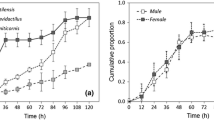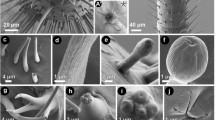Abstract
The responses of Australian hermit crabs to two types of shell-related odor cues were compared. Introduction of gastropod snail odor elicited an increase in grasping of shells in all four species tested (Clibanarius infraspinatus, C. taeniatus, C. virescens, andDiogenes avarus). However, the magnitude of response in the case ofC. virescens was significantly lower than the responses of individuals of the other species. Individuals ofC. infraspinatus responded to introduction of conspecific hemolymph with an increase in both locomotion and the frequency of grasping of shells.C. infraspinatus also responded to the hemolymph of the other three species, and there were no differences in the magnitude of the responses depending upon the source of the hemolymph. When individuals ofC. infraspinatus were exposed to snail odor and conspecific hemolymph at the same time, the responses were indistinguishable from those shown to hemolymph alone.
Similar content being viewed by others
References
Haig, J., andBall, E. E. 1988. Hermit crabs from North Australian and eastern Indonesian waters (Crustacea Decapoda: Anomura: Paguroidea) collected during the 1975Alpha Helix expedition.Rec. Aust. Mus. 40:151–196.
Hazlett, B. A. 1979. Individual distance in crustacea: IV. Distance and dominance hierarchies inPagurus pollicaris.Mar. Behav. Physiol. 6:225–242.
Hazlett, B. A. 1981. The behavioral ecology of hermit crabs.Annu. Rev. Ecol. Syst. 12:1–22.
Hazlett, B. A. 1996a. Organisation of hermit crab behaviour: Responses to multiple chemical inputs.Behaviour 133:619–642.
Hazlett, B. A. 1996b. The organisation of behaviour in hermit crabs: Responses to variation in stimulus strength.Behaviour In press.
Hazlett, B. A., andHerrnkind, W. 1980. Orientation to shell events by the hermit crabClibanarius vittatus (Bosc) (Decapoda, Paguridea).Crustaceana 39:311–314.
Hazlett, B. A., andRittschof, D. 1996. Multiple mechanisms of resource acquisition in hermit crabs: scrums and odor-induced grasping.Crustaceana. In press.
Katz, J. N., andRittschof, D. 1993. Alarm/investigation responses of hermit crabs as related to shell fit and crab size.Mar. Behav. Physiol. 22:171–182.
Kratt, C. M., andRittschof, D. 1991. Peptide attraction of hermit crabsClibanarius vittatus Bosc: Roles of enzymes and substrates.J. Chem. Ecol. 17:2347–2365.
MacDonald, J. D., Pike, R. B., andWilliamson, D. I. 1957. Larvae of the British species ofDiogenes, Pagurus, Anapagurus, andLithodes (Crustacea, Decapoda).Proc. Zool. Soc. London 128:209–257.
McLean, R. B. 1974. Direct shell acquisition by hermit crabs from gastropods.Experientia 30:206–208.
McLaughlin, P. A. 1983. Hermit crabs—are they really polyphyletic?J. Crust. Biol. 3:608–621.
Mitchell, B., andHazlett, B. A. 1996. Predator avoidance strategies of the crayfishOrconectes virilis.Crustaceana 69:400–412.
Rittschof, D., 1980a. Chemical attraction of hermit crabs and other attendants to simulated gastropod predation sites.J. Chem. Ecol. 6:103–118.
Rittschof, D., 1980b. Enzymatic production of small molecules attracting hermit crabs to simulated gastropod predation sites.J. Chem. Ecol. 6:665–675.
Rittschof, D., Kratt, C. M., andClare, A. S. 1990. Gastropod predation sites: the role of predator and prey in chemical attraction of the hermit crabClibanarius vittatus.J. Mar. Biol. Assoc. U.K. 70:583–596.
Rittschof, C., Tsai, D. W., Massey, P. G., Blanco, L., Kueber, G. L., Jr., andHaas, R. J., Jr. 1992. Chemical mediation of behavior in hermit crabs: alarm and aggregation cues.J. Chem. Ecol. 18:959–984.
Small, M. P., andThacker, R. W. 1994. Land hermit crabs use odors of dead conspecifics to locate shells.J. Exp. Mar. Biol. Ecol. 182:169–182.
Thacker, R. W. 1994. Volatile shell-investigation cues of land hermit crabs: effect of shell fit, detection of cues from other hermit crab species, and cue isolation.J. Chem. Ecol. 20:1457–1482.
Wilkinson, L. 1988. Systat, the System for Statistics. Systat. Inc., Evanston, Illinois.
Author information
Authors and Affiliations
Rights and permissions
About this article
Cite this article
Hazlett, B.A. Comparative study of hermit crab responses to shell-related chemical cues. J Chem Ecol 22, 2317–2329 (1996). https://doi.org/10.1007/BF02029549
Received:
Accepted:
Issue Date:
DOI: https://doi.org/10.1007/BF02029549




